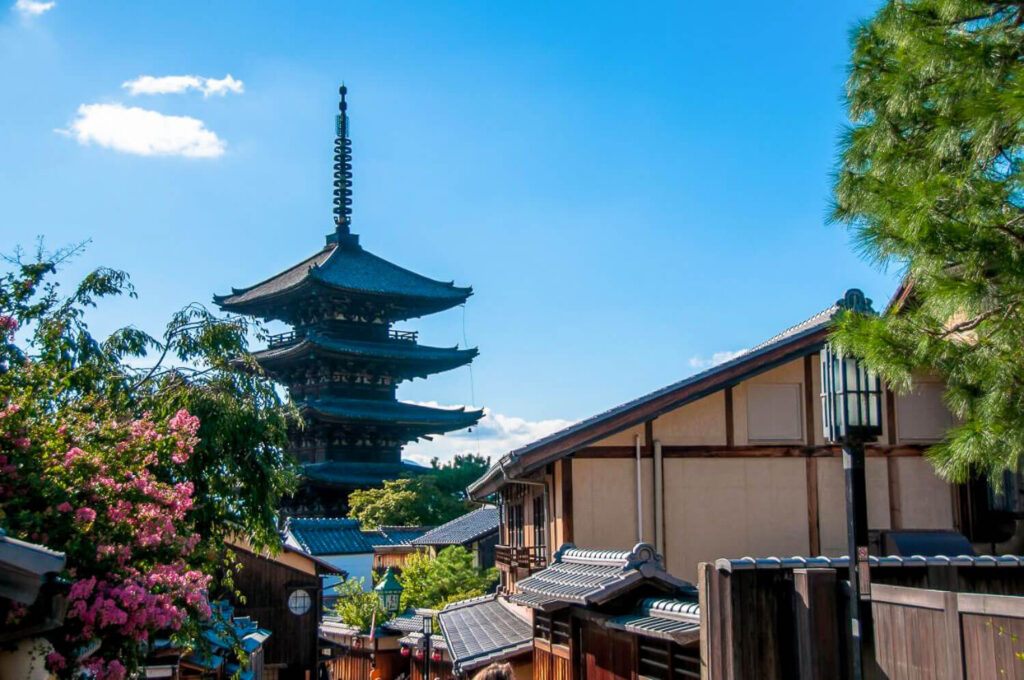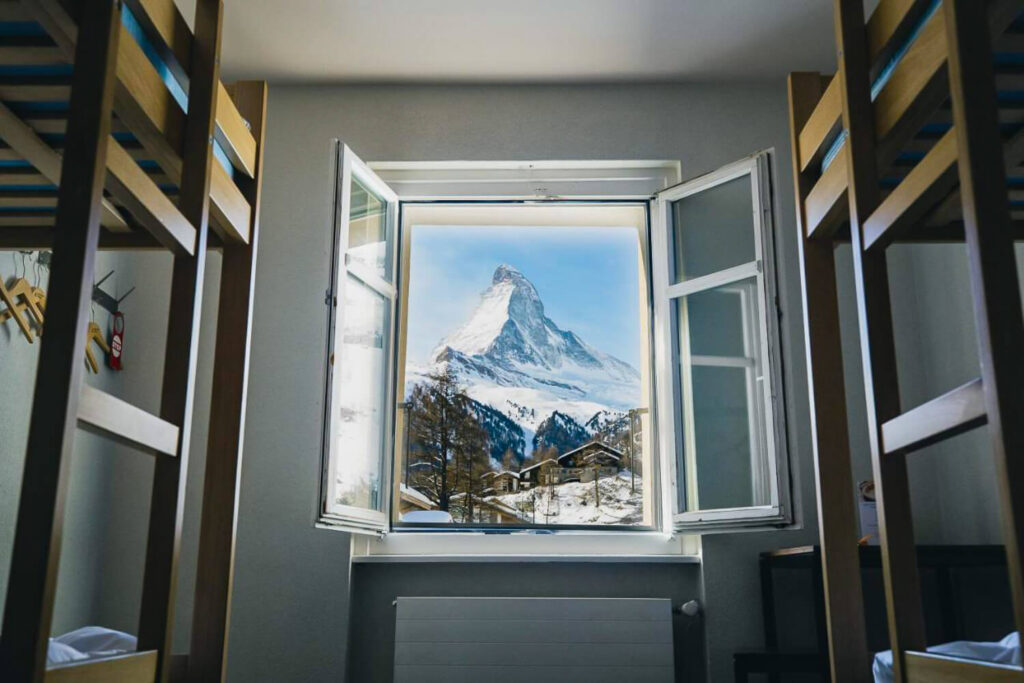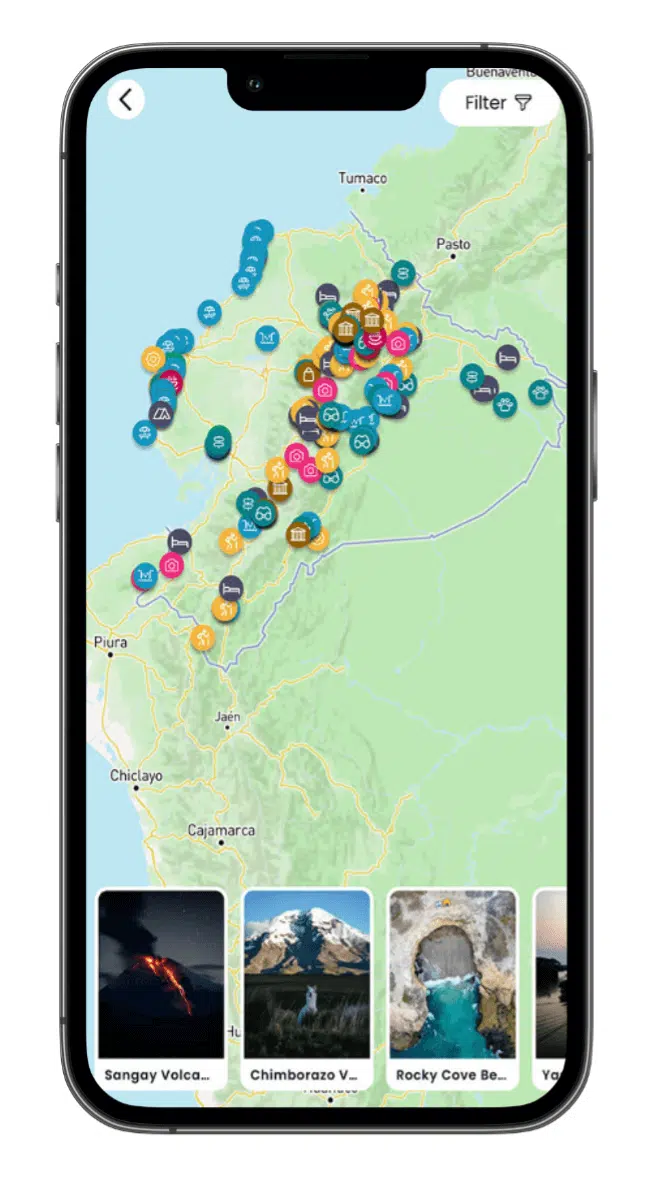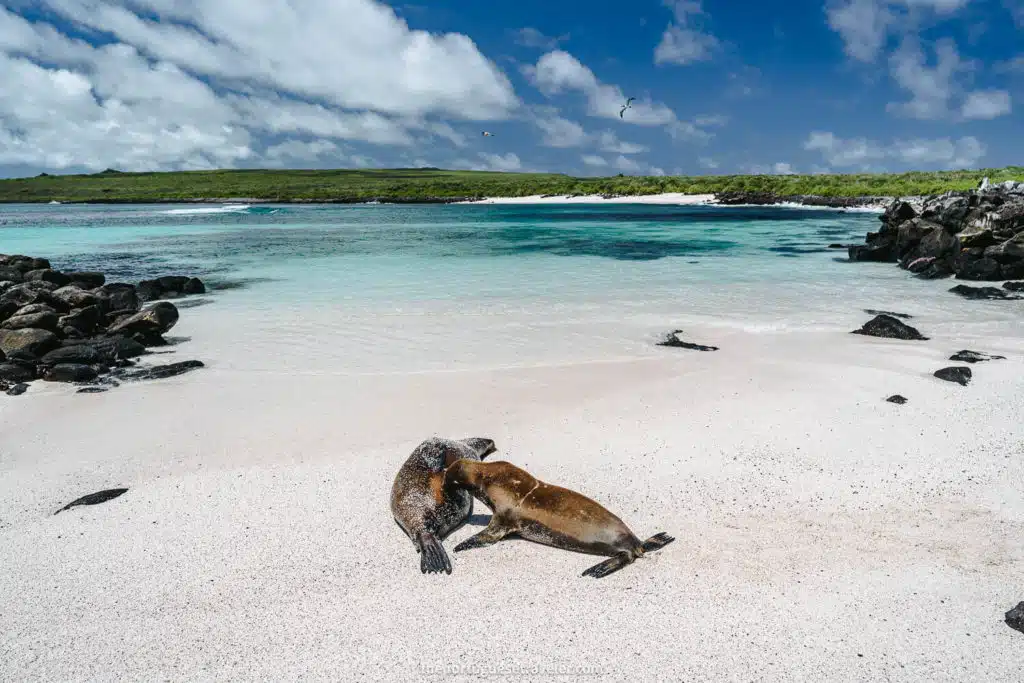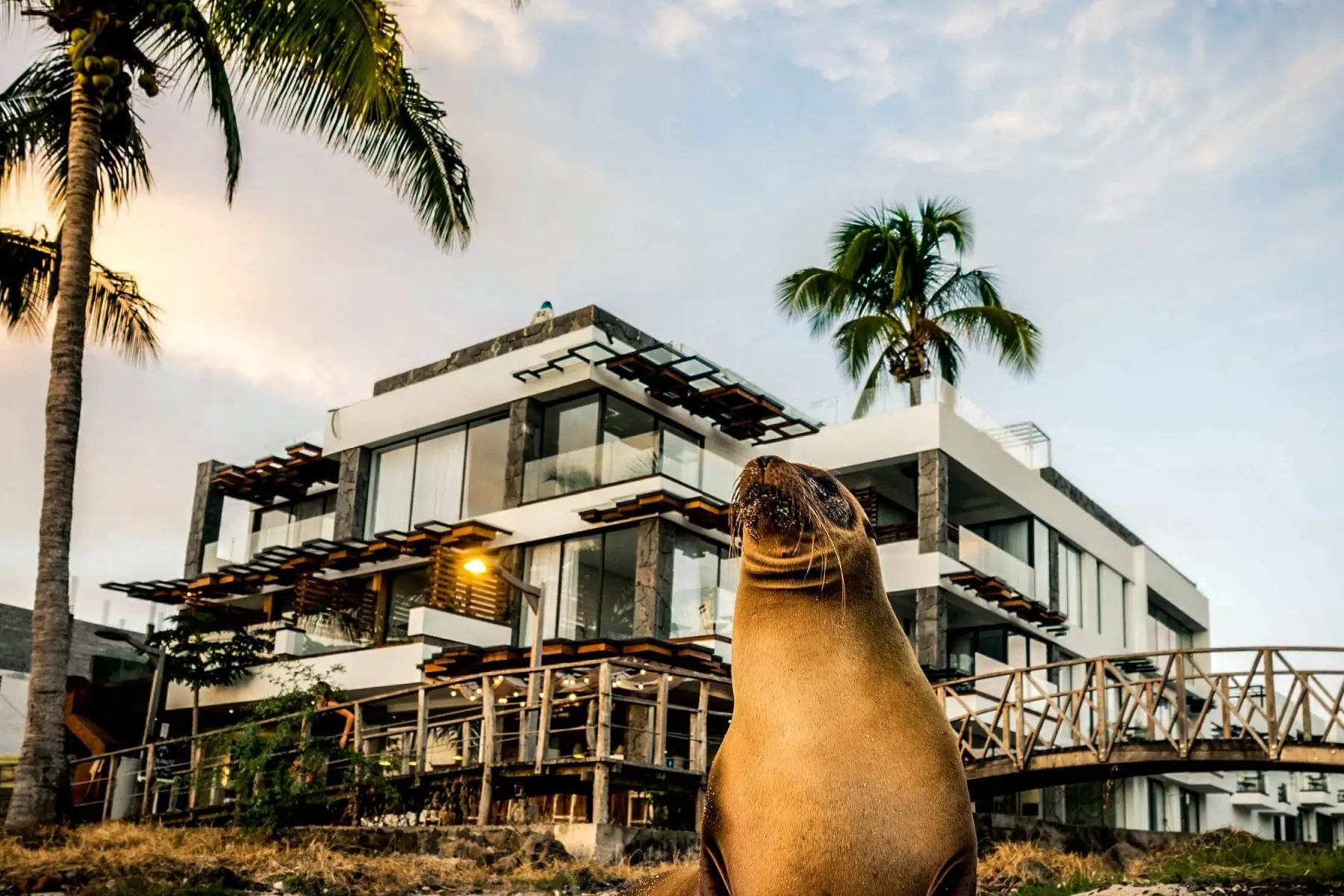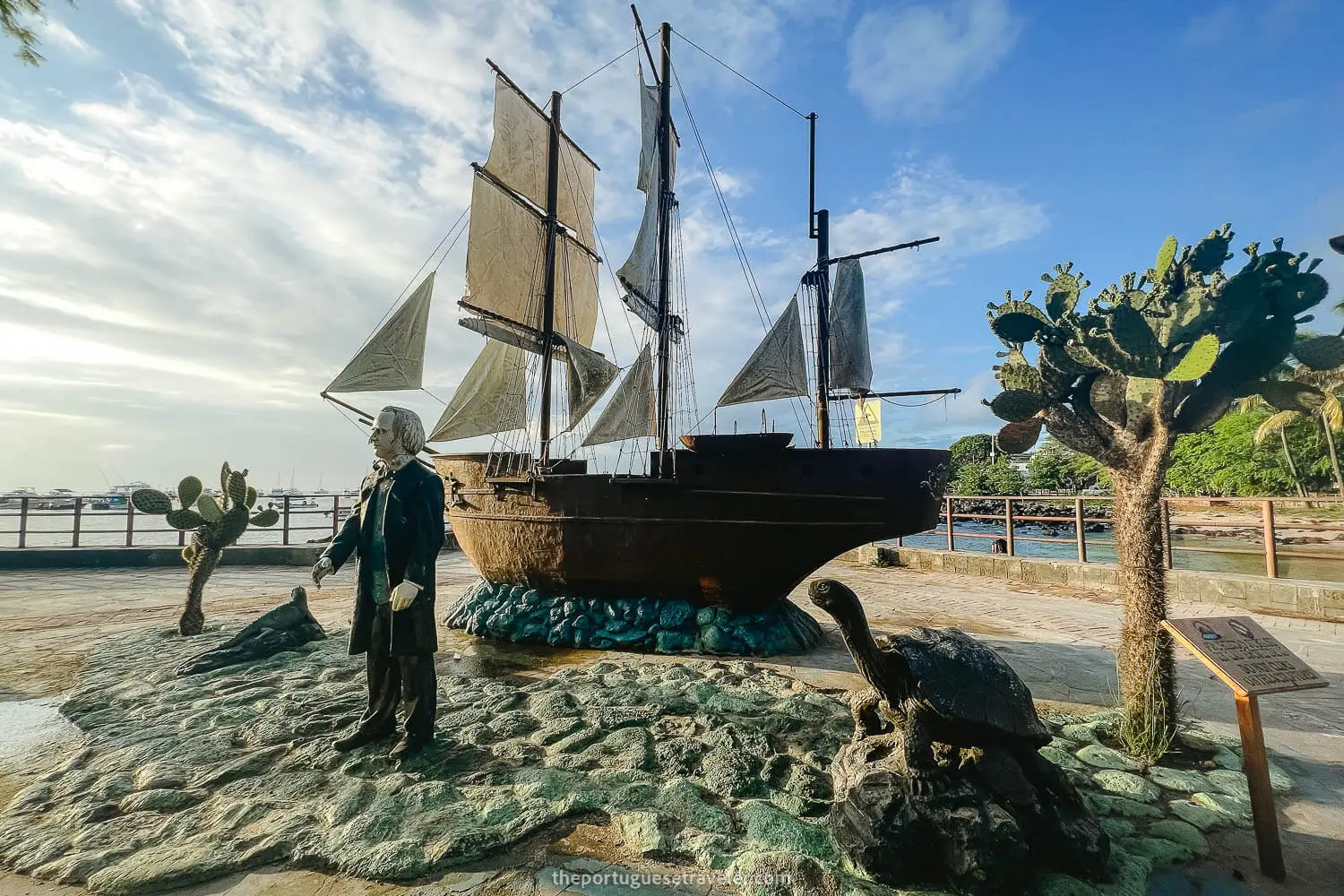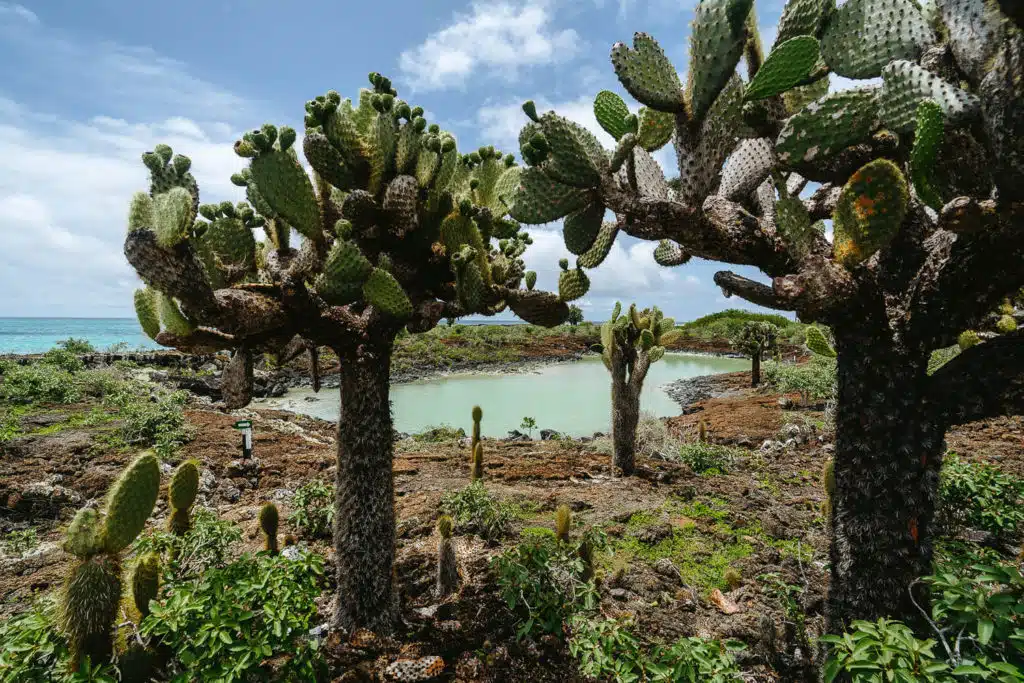Diving in Carawa Wreck and Tijeretas Bay
San Cristobal Dive Sites
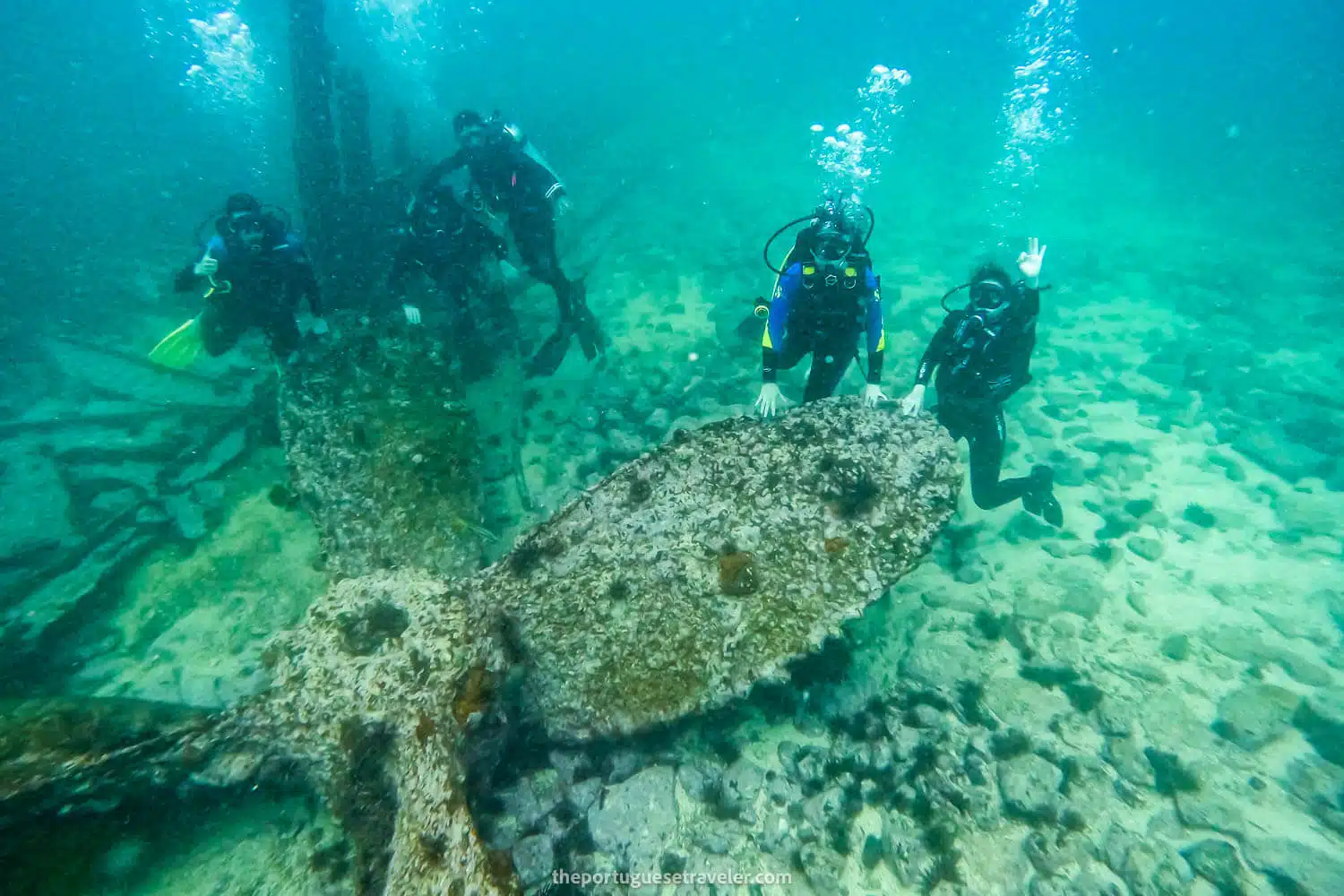
Discover the wonders of Carawa SS Wreck, a German (or Australian) transport ship that found its resting place in 1920, stretching approximately 100 meters in length. Before delving into the intriguing depths of the wreck, divers begin their journey with a check dive at Tijeretas Bay, a natural lagoon boasting crystal-clear waters and inhabited by playful sea lions and graceful green sea turtles.
Table of Contents
Travel Guide, Itineraries, Map, Local Tips
Get access to my curated list of all the best viewpoints, hiking trails, secret waterfalls, diving spots, wildlife tours, accommodations, and more, that will make your trip to Ecuador and The Galapagos unforgettable.
All of this, in an interactive guide featuring a mobile-friendly map, pre-designed itineraries, all my favourite photos, and helpful travel tips to guide your journey in this amazing unexplored country.
If you want personalized advice write me in-app and we can plan it together.

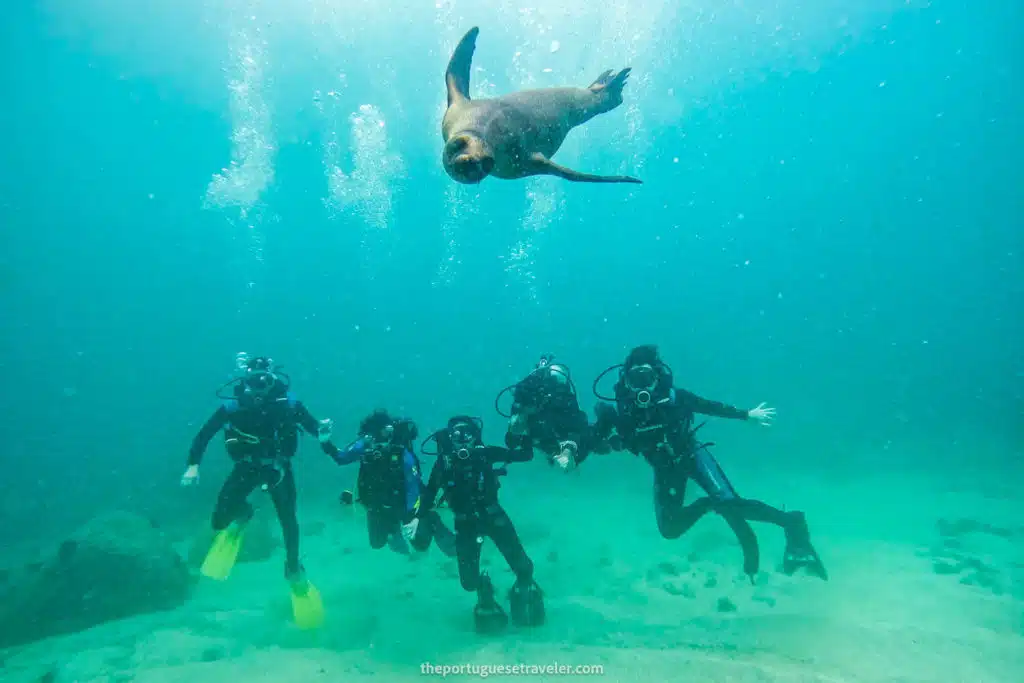
Diving in Carawa & Tijeretas: General Info
Whether you’re new to diving or a seasoned enthusiast, the tour to Carawa Wreck and Tijeretas Bay in San Cristobal is a must-do experience. It is renowned as a popular choice for both discovery dives and thrilling fun dives.
- Highlights: Check dive at the picturesque Muelle Tijeretas (Tijeretas Bay), with crystal-clear waters and playful sea lions. Exploration of the Carawa SS Wreck, a transport ship that sunk around 1920
- Duration: Half Day (Can be done either in the morning or afternoon)
- Price: 190$ USD.
- Agency/Guide: Aquaventures Dive Center
- Included on the tour: Boat transportation, Diving equipment, Box lunch, an Experienced Divemaster, and a Knowledgeable Naturalist Guide.
Diving in Carawa & Tijeretas: Technical Info
- Dive Type: Wreck Dive (limited penetration) & Open Water Dive.
- Difficulty: Easy (Discovery).
- Start: Boat dive.
- Duration: Around 45 minutes.
- Nr. of dives: 2 dives.
- Full Tank: 3000 PSI / 200 Bar
- Currents: None, or low currents.
- Max. Depth: 15 meters.
- Surface Interval: 1 hour (boat rest).
- Visibility: 7-20 meters.
- Water Temp. (ºC): Jan-Apr: 23,4-30,5. May-Dec: 21,0-27,5.
- Air Temp. (ºC): Jan-Apr: 22-31, May-Dec: 19-29.
- Water Temp. (ºF): Jan-Apr: 76,8-84,3, May-Dec: 71,9-79,3.
- Air Temp. (ºF): Jan-Apr: 72-88, May-Dec: 66-84.
Making the Most of Your Carawa Shipwreck Diving Adventure
The waters around San Cristobal are full of incredible marine life, and while I couldn’t find tours specifically for the Carawa Shipwreck, I found some top-rated snorkeling trips so you can still have an unforgettable underwater experience. These tours take you to Kicker Rock (León Dormido) and other stunning spots, where you can swim alongside sharks, rays, and vibrant sea creatures.
If you’re set on diving at the Carawa Shipwreck, check the following sections for tips on how to arrange it:
Diving in Carawa & Tijeretas: Curiosities
Carawa Wreck: The shipwreck at Carawa has two versions of its story, each offering a different perspective.
The first account relates to a German transport ship called Caragua, measuring 100 meters in length, which met its demise in November 1918.
The second, more comprehensive version unveils a captivating history surrounding the ship. Originally known as the Croatian vessel Turul SS, it was constructed in 1907 and later seized in Sydney in August 1914. Renamed as Carawa SS, tragedy struck on March 21, 1920, when the ship wrecked on San Cristobal Island in the Galapagos Islands. It was on a journey from Port Arthur, Texas, to Brisbane, carrying a cargo of cased gasoline. This historic wreck presents divers with a unique opportunity to delve into the remnants of this ill-fated vessel and uncover its intriguing past.
A brief story of the wreck according to the National Library of Australia:
“S.S. CARAWA WRECK.
Story of Survivors.
SYDNEY Sunday – Some of the crew of the Commonwealth Government liner Carawa which was wrecked on a reef in the Galapagos group on March 21 and became a total loss reached Sydney on Saturday evening by the steamer Australrange. Their names are Bond, Lucas Roberts, Lewis, Ross, O’Brien, Mullen, Boreham McDonald, Fannigan, Beck, Whytt and Welch. Captain Hyde and a member named Gasper are returning to Australia by a liner calling at Panama. The Australmount, which is due here from Cuba shortly, has the following members of the crew on board: – Robinson, Gore, Cassidy, Lane, Eliston, Kelly, Morris, Bartholomew, and Ford. Mr James Mullen one of the returned men gives the following account:
The Carawa struck a reef about a mile from the shore. The rudder and stern post were torn away and the vessel became hard and fast We remained on her for four days, when the high tide floated her off the reef into deep water. There were no tugs at the island, and our position was becoming serious. It was then found that the vessel was leaking badly in the forehold, and it was decided to leave it and make for the shore.
The Carawa sank in about 40ft of water. Her masts, funnel, and bridge could be seen above waiter. We made a tent out of awnings we brought from the ship, and subsisted on tinned meats and potatoes we had brought ashore with us. Our supply of food was very limited. Sleep was practically out of the question due to mosquitoes.
There were about 500 Spanish convicts on the island who seemed to have been put there and not further troubled about. Belongings of mine valued at £90, were stolen from me. I am certain that the limejuice which we got from the ship and the wild oranges we gathered kept us in health. Not one of our men became ill. We were four weeks on the island before we were transhipped to the 100 ton schooner Manual Cobalt which had bullocks and pigs aboard. Our walking room was confined to about five yards, and we had no means whatever of washing ourselves. Our food consisted of stew and beans once a day only.
We were aboard this schooner for 18 days. We at last reached Guayaquil, where we fared better than we had since the wreck. We then sailed to Colon by the steamer Quertmayle, sleeping on the deck with a blanket to cover us. On reaching Colon we lived at the Salvation Army Home till we were transferred to the Australrange.”
For more info check: Wrecksite Website, National Library of Australia – Page 1, and Page 2
Tijeretas Dive: Tijeretas Bay, also known as Muelle Tijeretas or Darwin Bay, holds its own secrets and allure. Dive into its crystal clear waters and witness the playful antics of the resident sea lions. As you explore the shallow areas, you may encounter green sea turtles gracefully chewing on algae-covered rocks. Tijeretas Bay offers a delightful dive location for divers of all levels, providing a mesmerizing glimpse into the marine life that inhabits this enchanting natural lagoon.
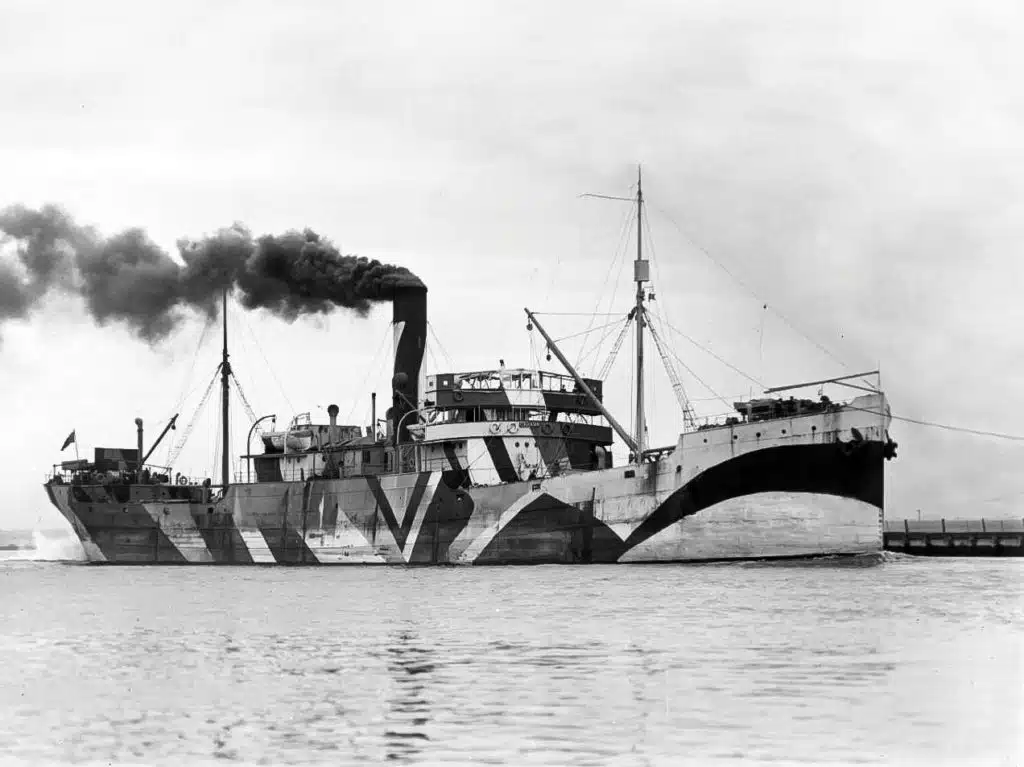
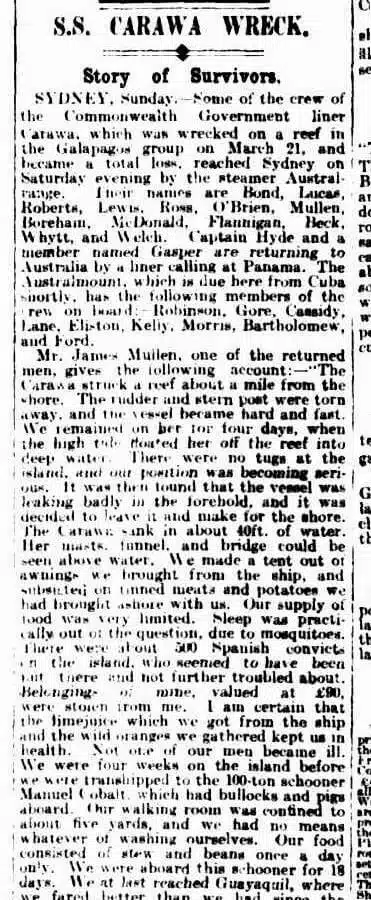
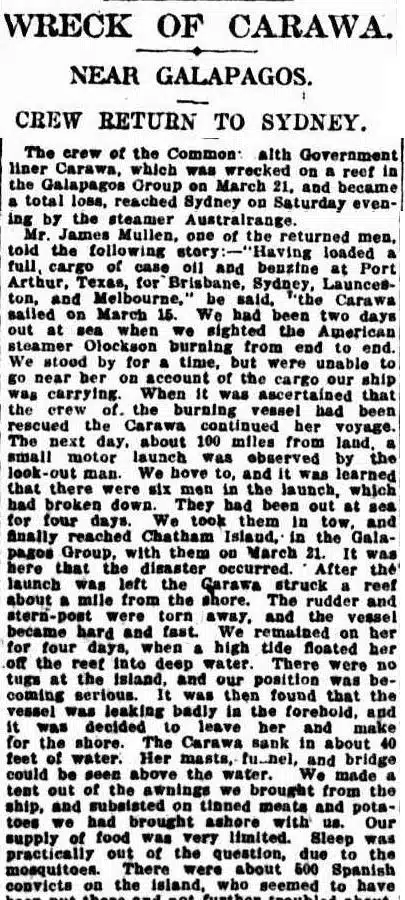
How to do dive in Carawa Wreck and Tijeretas Bay?
If you’re interested in diving at the renowned Carawa Wreck and Tijeretas sites in the Galapagos Islands, there are several options available to you. One recommended choice is to join a tour organized by Aquaventures Dive Center, which offers a Discovery Dive program designed specifically for beginners. This program provides an exceptional opportunity to experience diving for the first time in these captivating locations.
However, it’s worth noting that there are other diving schools in the area, such as Wreck Bay Dive Center, that may offer more affordable options. It’s advisable to explore different schools and compare prices to find the best fit for your preferences and budget.
Whether you choose Aquaventures Dive Center or another reputable school, diving in Carawa Wreck and Tijeretas is sure to be an incredible adventure, allowing you to explore the enchanting underwater world of the Galapagos Islands.
What can i see while diving in Carawa Wreck and Tijeretas Bay?
Here’s a glimpse of what you can expect to see during your underwater exploration:
- Carawa Wreck: This sunken cargo vessel holds a fascinating historical allure. As you dive around the wreckage, you may discover remnants of the ship’s structure, including the boiler room and propellers. The vibrant reef that has grown over the wreck attracts an array of marine species.
- Tijeretas Bay: This natural lagoon teems with life and serves as a favorite playground for playful sea lions. As you descend into the crystal-clear waters, keep an eye out for green sea turtles gracefully grazing on algae-covered rocks. The shallow areas are often frequented by colorful fish, adding an extra splash of beauty to your dive.
- Marine Life: Prepare to be mesmerized by the rich biodiversity of these dive sites. Schools of fish gracefully navigate through the waters, while rays glide effortlessly by. Keep your eyes peeled for scorpion fish camouflaged amidst the coral, and if you’re lucky, you might even spot a reef shark or a majestic sea turtle.
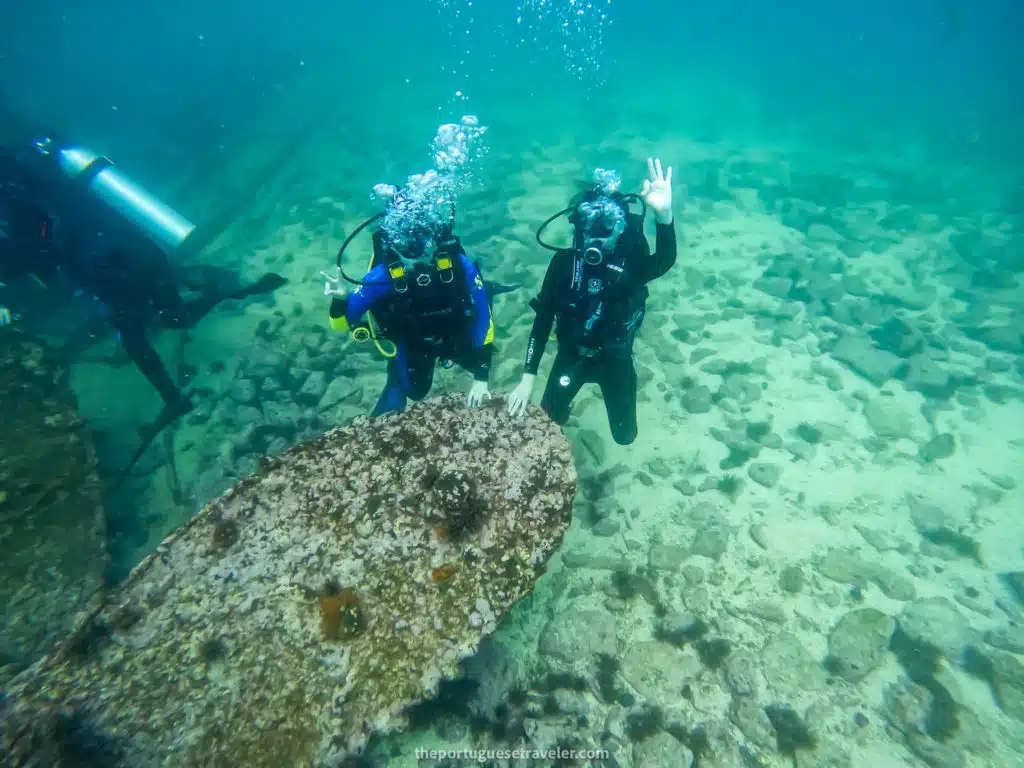
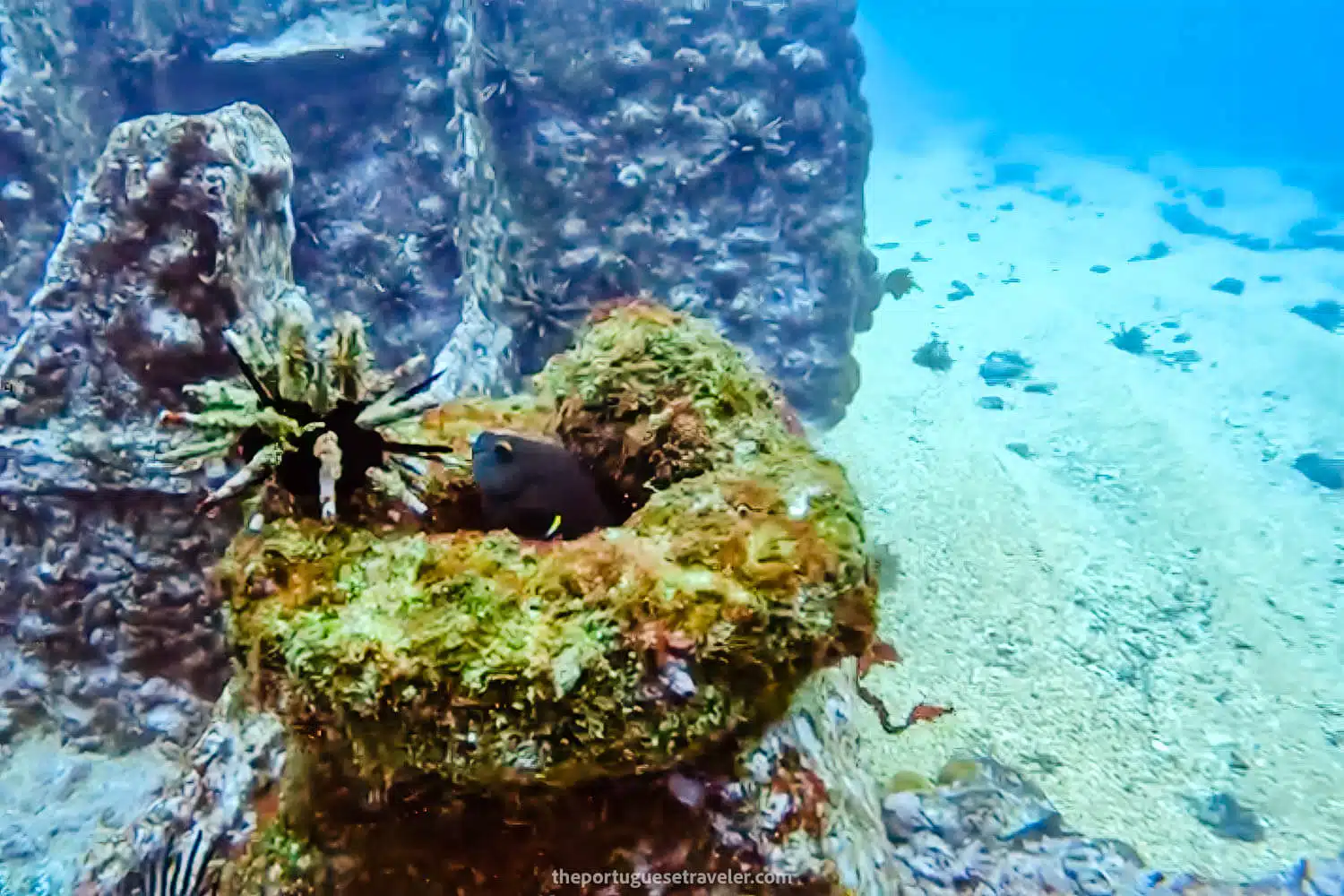
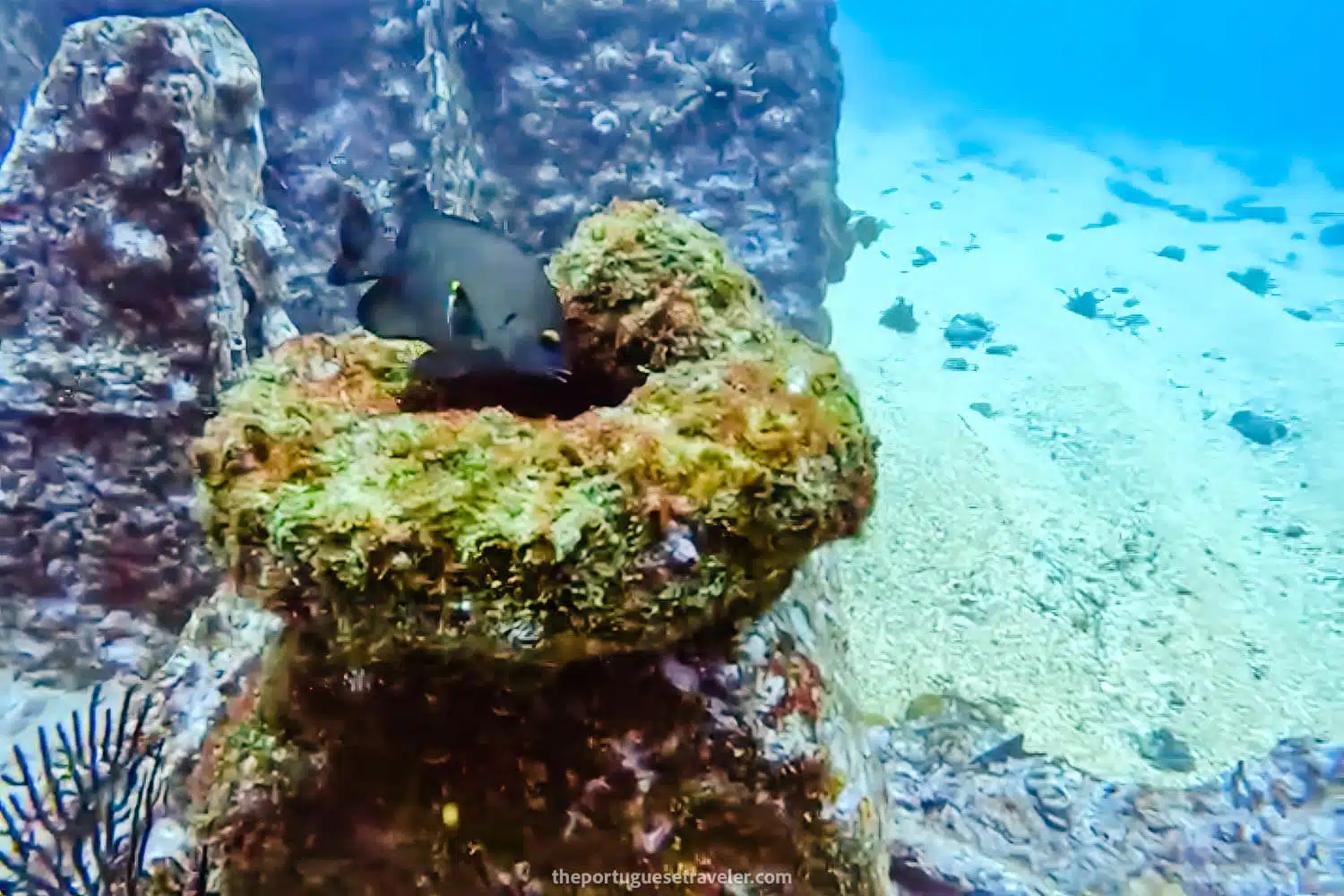
What should i bring to the dive in Carawa Wreck and Tijeretas Bay?
Diving Computer:
Diving Gear:
Clothing & Accessories:
- Tshirt: Breathable Tshirt (Tech or Merino), or a Lycra
- Jacket: Waterproof Jacket
- Shorts: Swimming Clothes
- Shoes: Flip Flops
- Hat: Cap
- Sunglasses
- Dry-fast Towel
- Earth Pak Waterproof Dry Bag
- Change of Clothes
Useful Extras:
- GoPro/Camera
- First-Aid Kit – Extra Sea Sickness Medication if needed
- Sunscreen 50 SPF
- Food / Snacks
- Thermos or Water-filtering Bottle
Check out my complete guide on What’s in My Backpack – From photography gear, and clothing for Hiking, Mountaineering, Scuba Diving, Rainforest, and City-Street Photography.
My Experience while diving in Carawa Wreck and Tijeretas Bay
Although I didn’t have the opportunity to dive in Carawa Wreck and Tijeretas Bay myself, I was lucky enough to hear all about my friends’ incredible adventure in these mesmerizing underwater sites. They were in awe of the marine wonders they encountered and couldn’t stop raving about their experience.
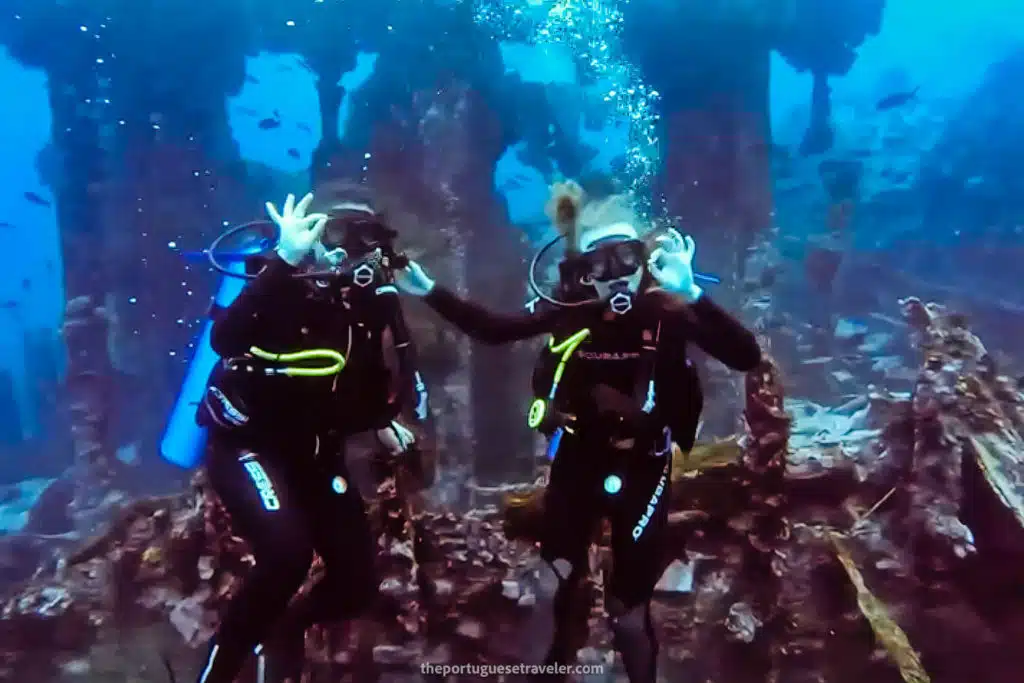
Diving in Tijeretas Bay
In Tijeretas Bay, they were greeted by the enchanting sight of numerous sea lions frolicking in the crystal-clear waters. These playful creatures accompanied them throughout their dive, adding an extra element of excitement to their underwater exploration. My friends were thrilled as the sea lions swam gracefully around them, creating unforgettable moments and providing excellent photo opportunities.
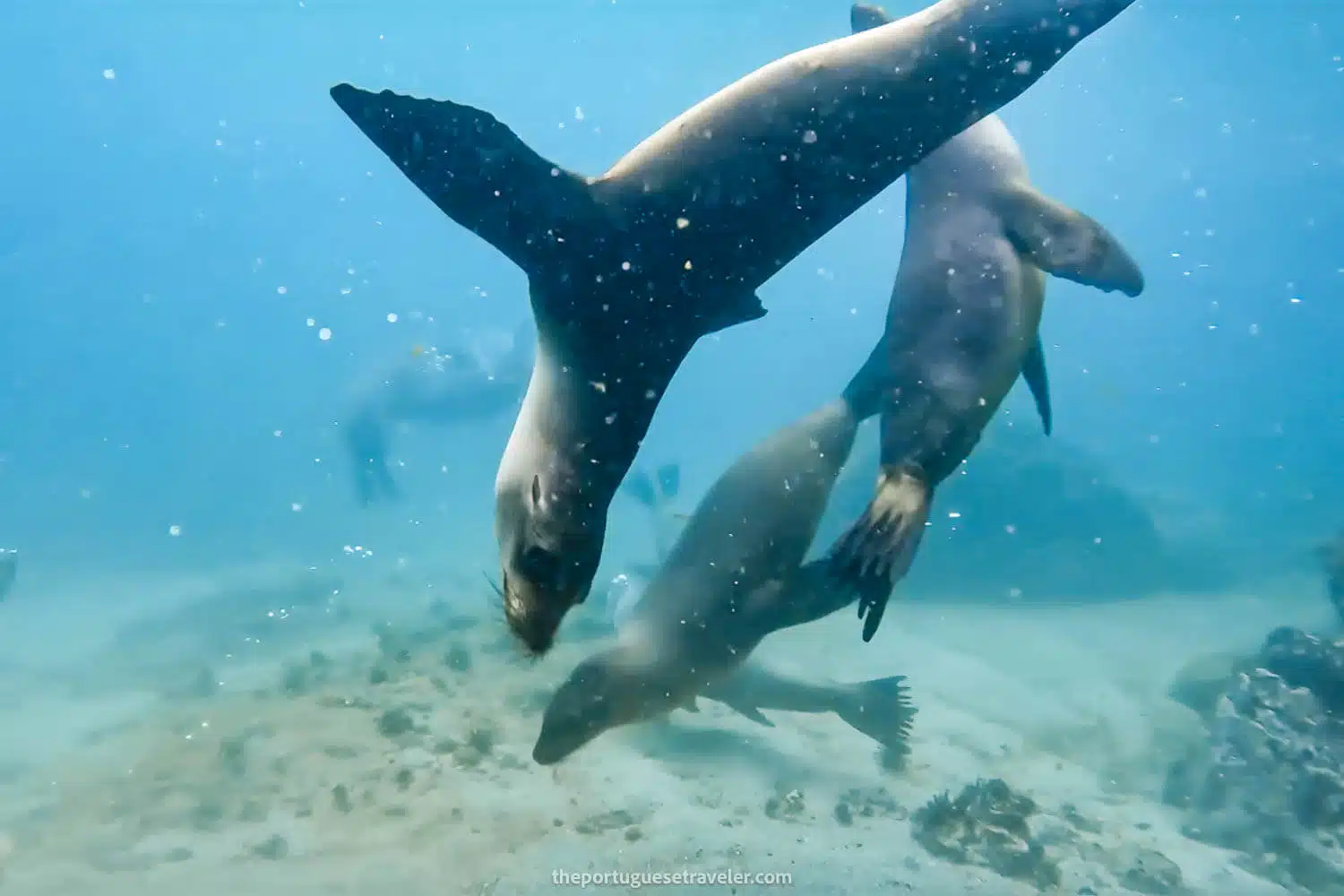
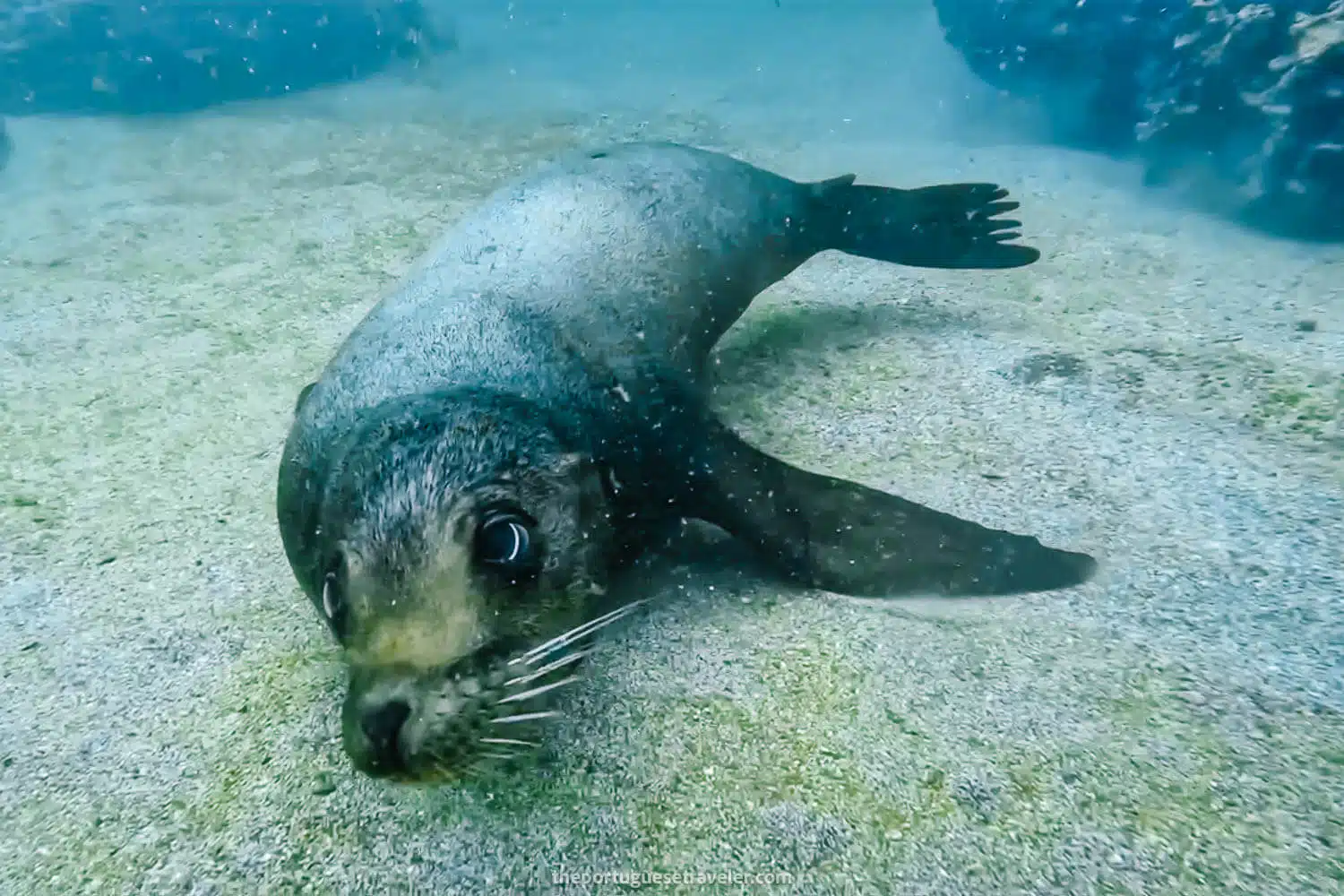
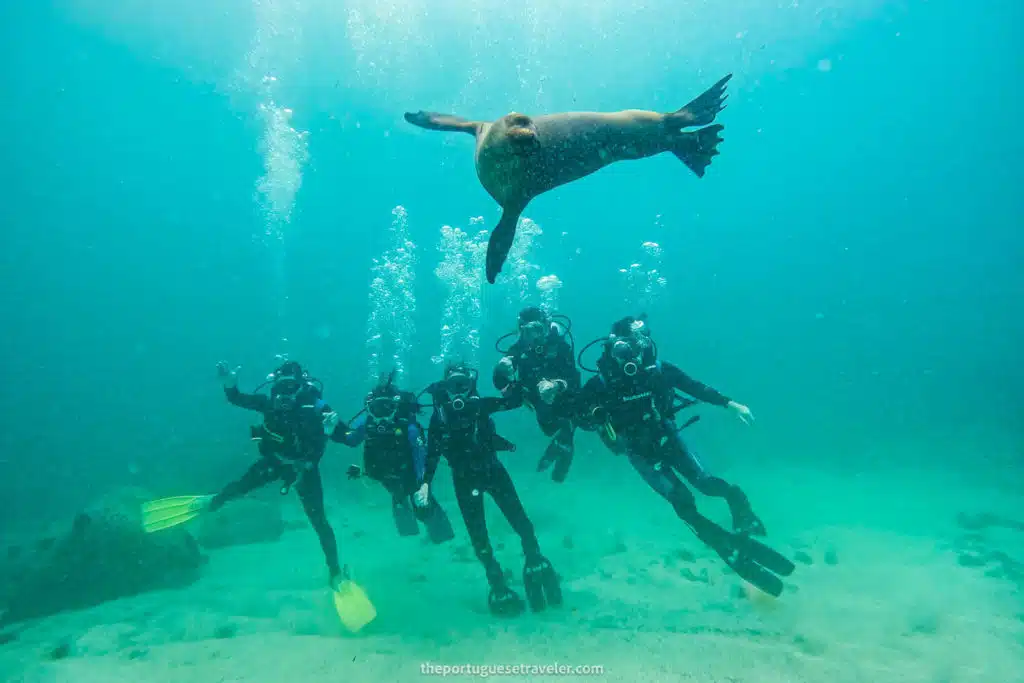
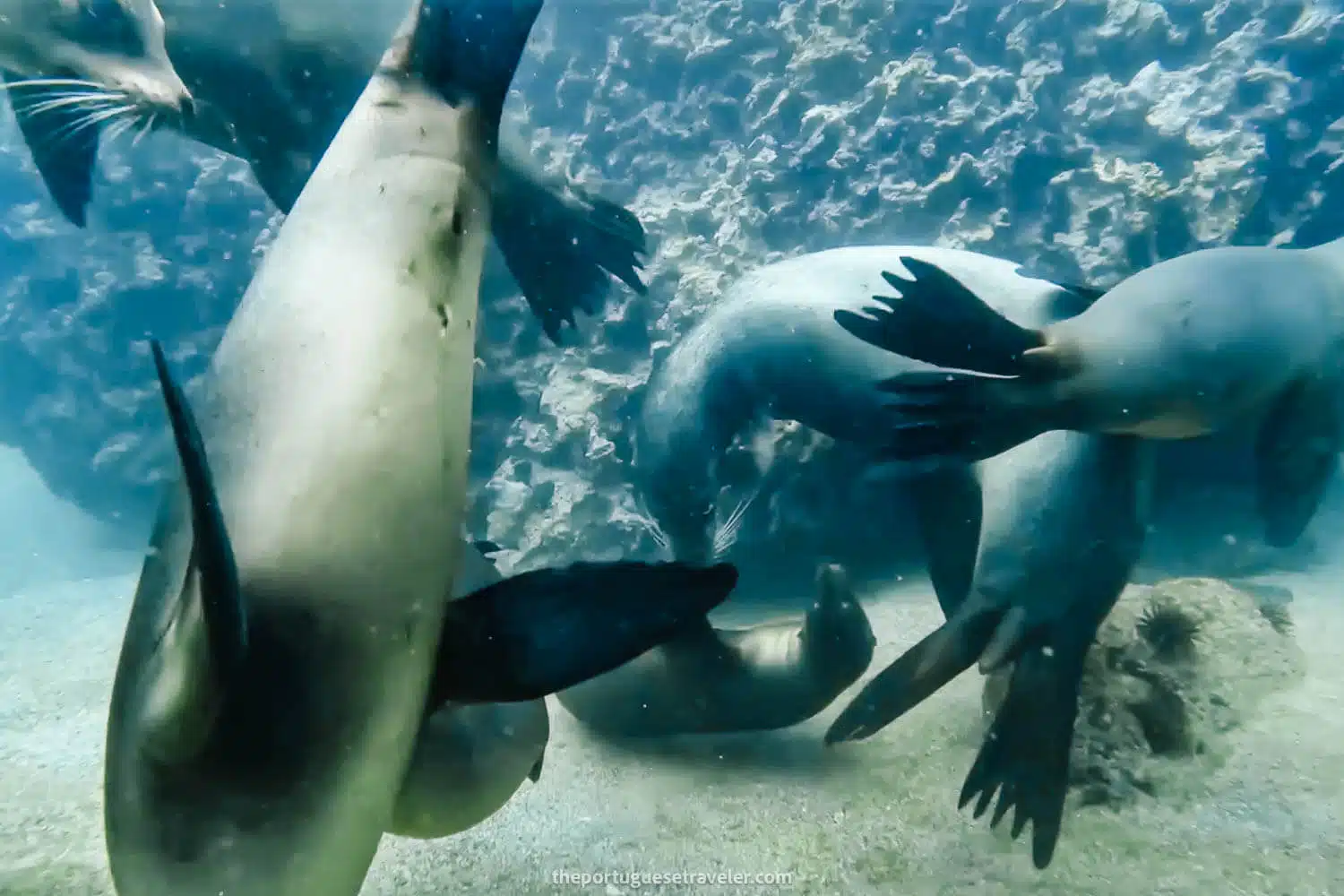
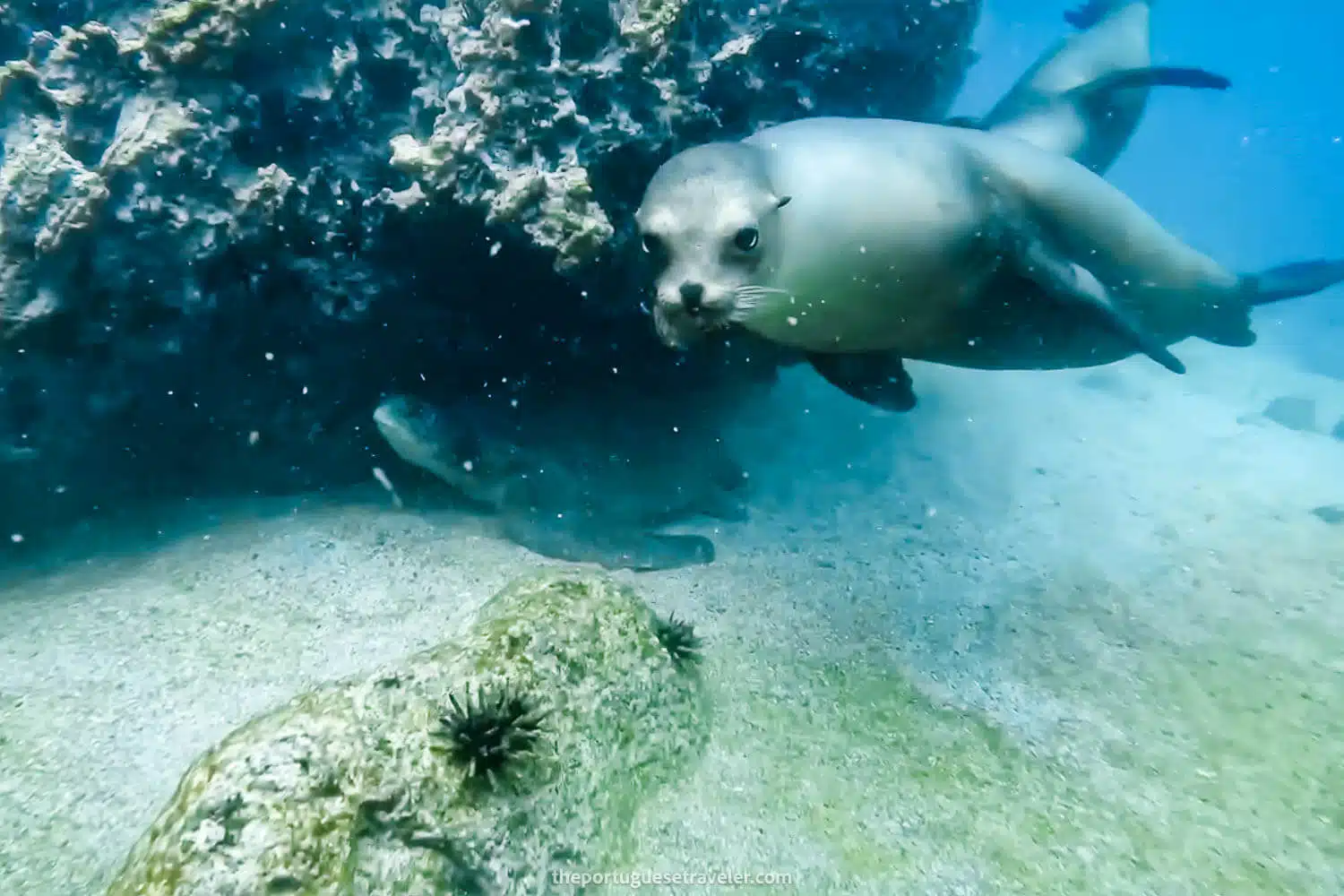
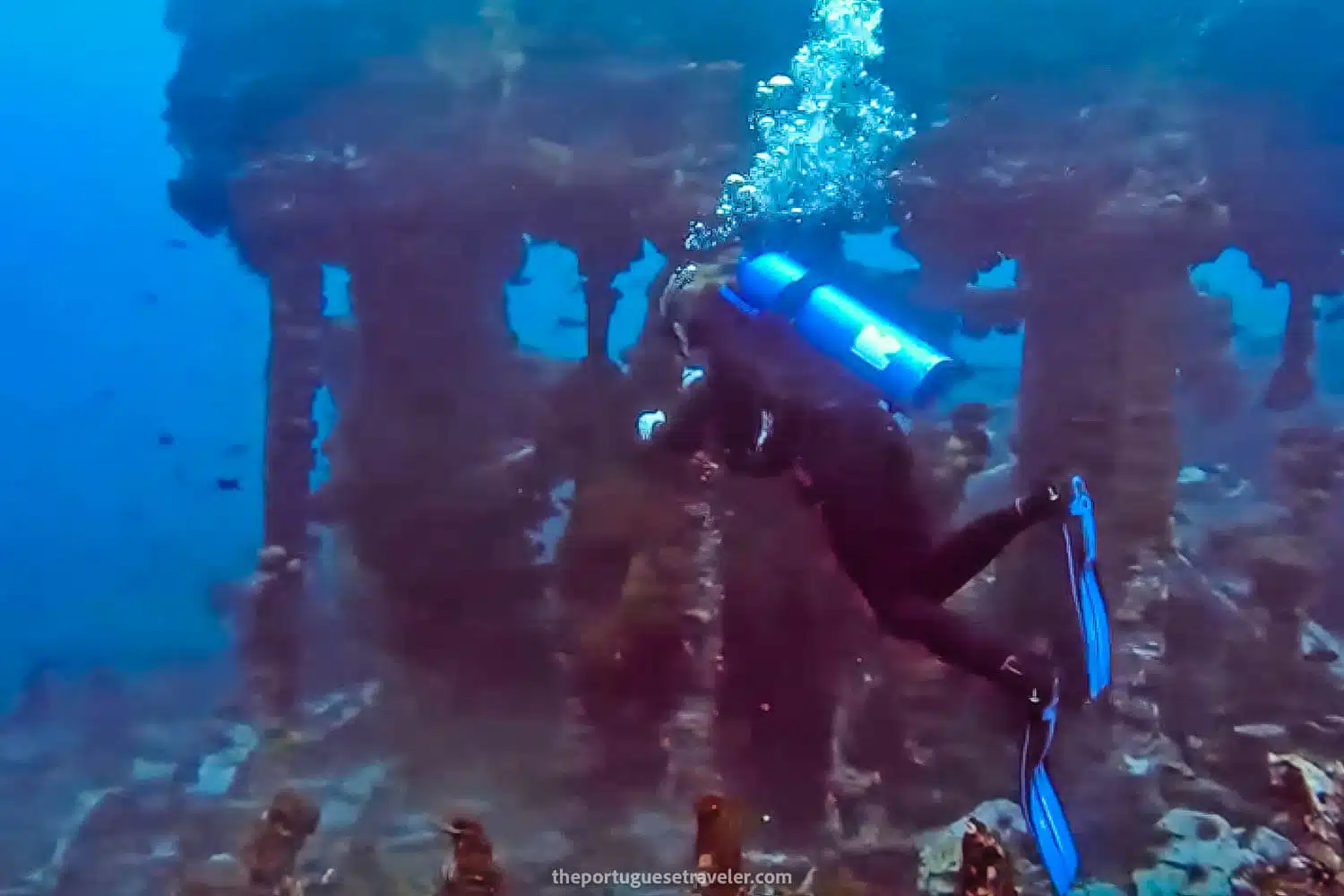
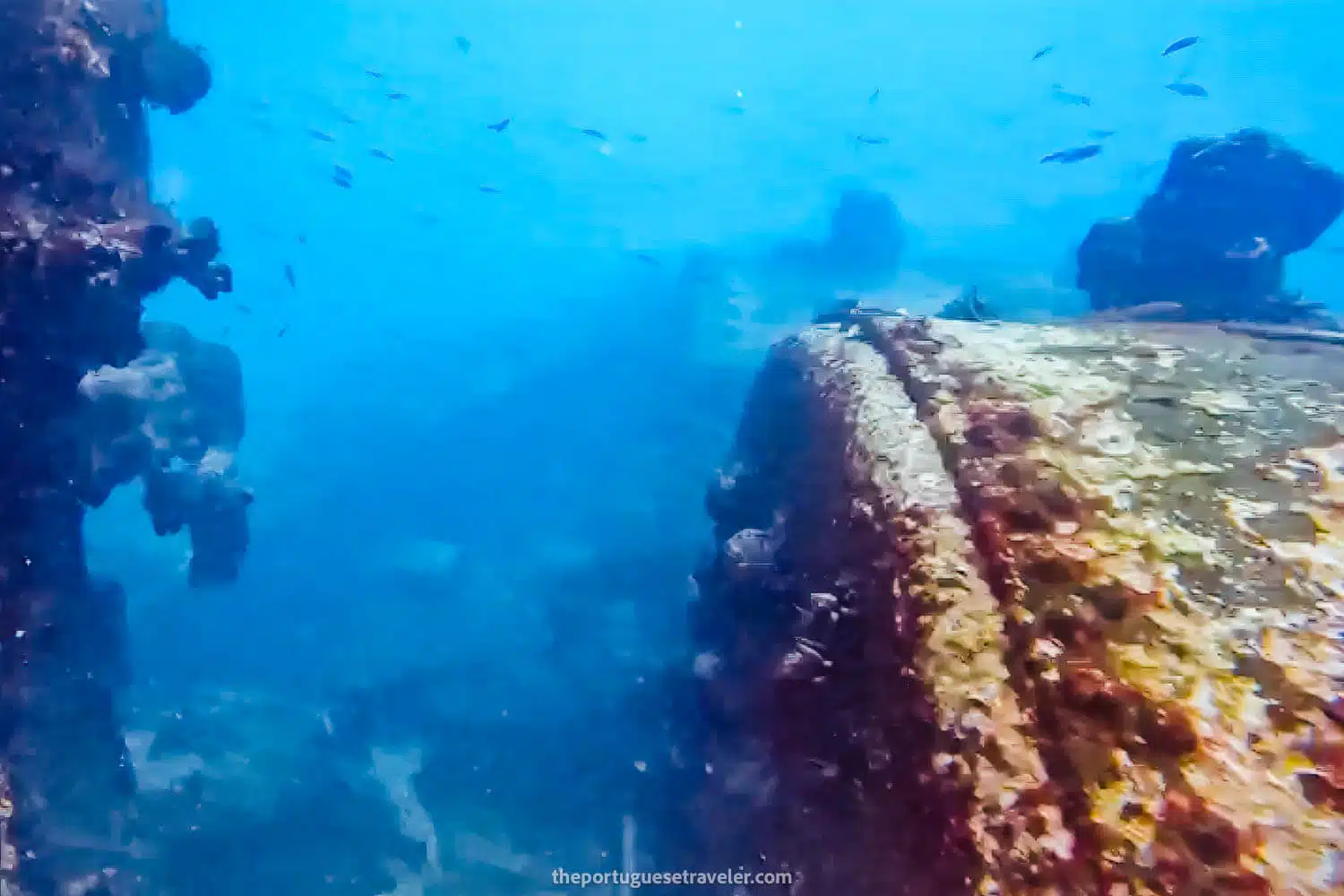
Diving in Carawa Wreck
Moving on to the Carawa Wreck, my friends were captivated by the rich history that surrounds this sunken cargo vessel. They explored the wreckage and were amazed by the vibrant reef that had taken over the ship. As they ventured closer, they even managed to pose for some photos with the propeller, capturing memories they would cherish for a lifetime.
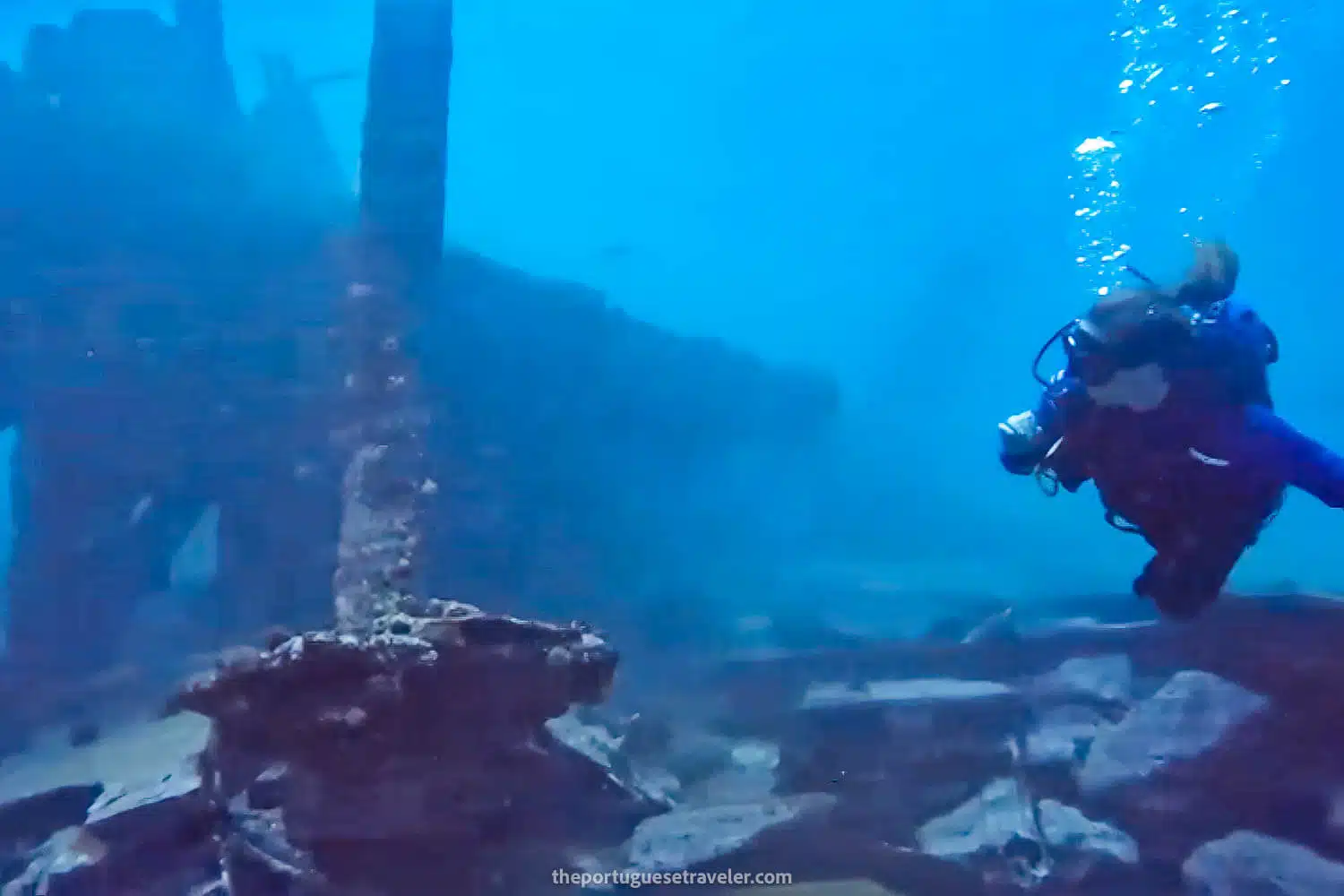
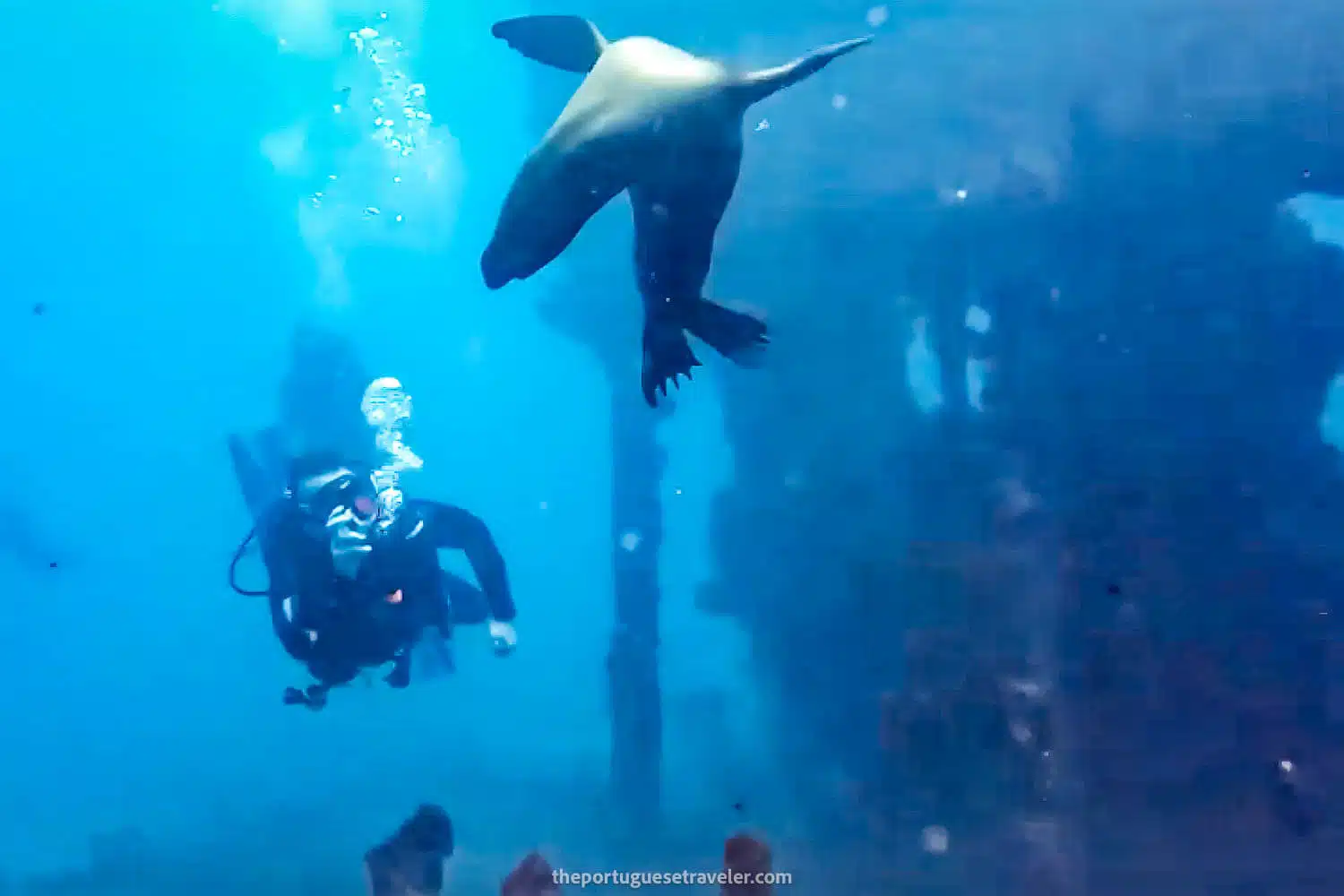
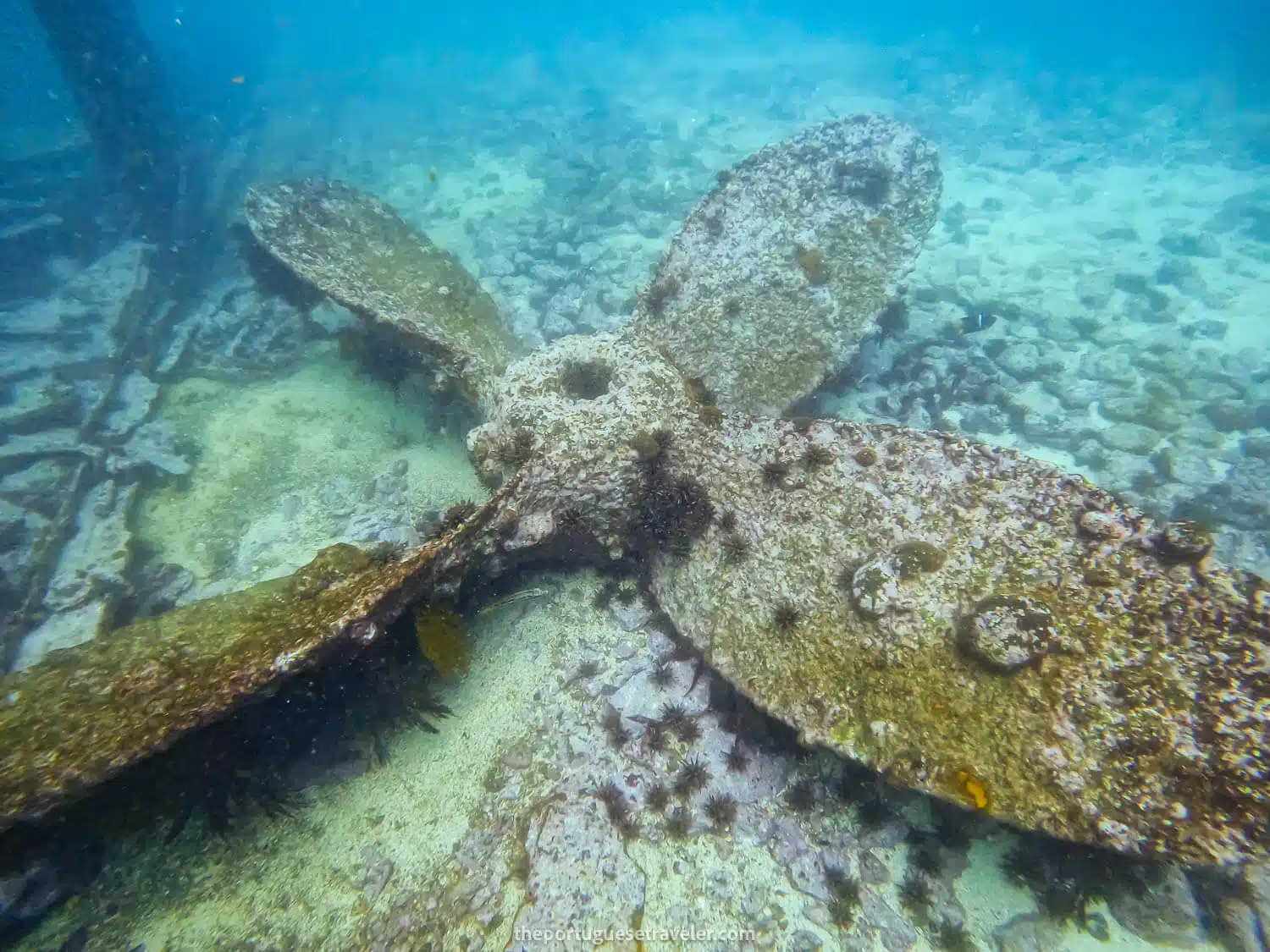
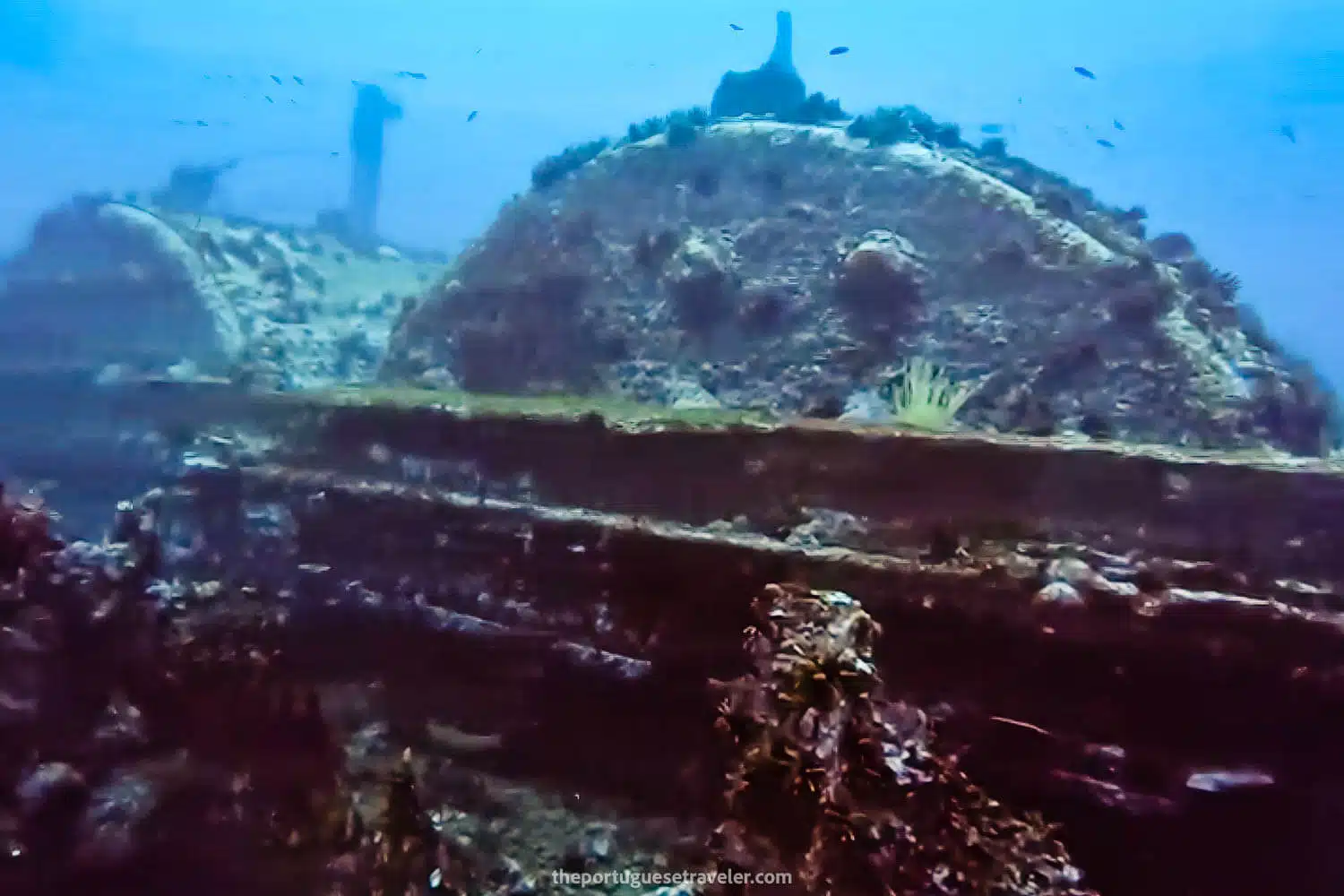
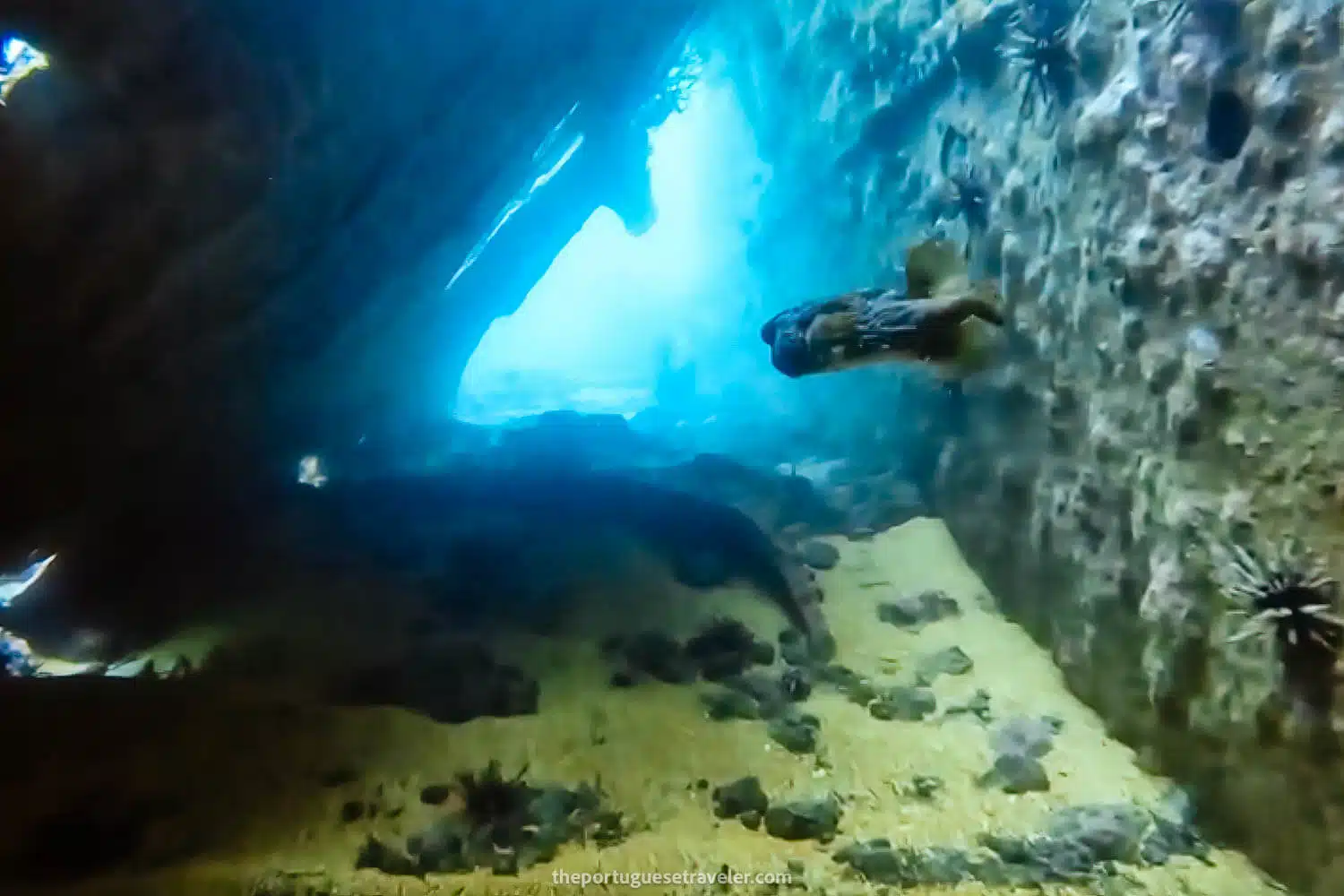
The abundance of sea lions both in Tijeretas Bay and around the Carawa Wreck made their diving experience truly exceptional. It was an unforgettable encounter with these charismatic marine creatures that left my friends with a profound appreciation for the beauty and diversity of Galapagos’ underwater world.
Although I missed out on this particular dive, hearing about my friends’ exhilarating encounters with sea lions and their overall satisfaction with the diving experience in Carawa Wreck and Tijeretas Bay only deepened my desire to explore these captivating sites on my next visit to the Galapagos Islands.
All the Articles About the Galapagos
San Cristobal Island – The easternmost island of the Galápagos, the “Isla Bonita”
Santa Cruz Island – The island with the best tourism infrastructure.
Isabela Island – The most adventurous and less explored island of the main three.
Plan your next adventure with us!
Here are the links we use and recommend to plan your trip easily and safely. You won’t pay more, and you’ll help keep the blog running!
Adventures in Sri Lanka - The Ancient Ceylon
Explore The Galapagos Islands
Hiking in Switzerland & Italy
The Hidden Worlds of Ecuador
ABOUT ME
I’m João Petersen, an explorer at heart, travel leader, and the creator of The Portuguese Traveler. Adventure tourism has always been my passion, and my goal is to turn my blog into a go-to resource for outdoor enthusiasts. Over the past few years, I’ve dedicated myself to exploring remote destinations, breathtaking landscapes, and fascinating cultures, sharing my experiences through a mix of storytelling and photography.
SUBSCRIBE
Don’t Miss Out! Be the first to know when I share new adventures—sign up for The Portuguese Traveler newsletter!
MEMBER OF
RECENT POSTS
COMMUNITY
GUIDES
Need help planning? Get our interactive Ecuador and Galapagos guides with curated itineraries. Learn more…
RELATED POSTS
TRAVEL INSURANCE
Lost luggage, missed flights, or medical emergencies – can you afford the risk? For peace of mind, I always trust Heymondo Travel Insurance.
Get 5% off your insurance with my link!



